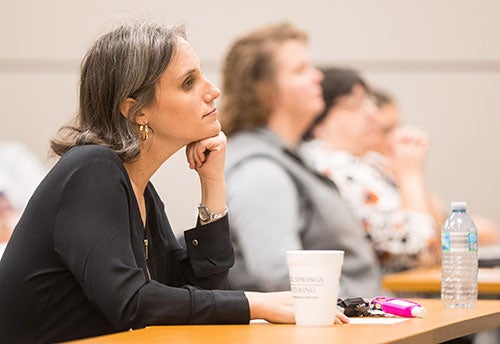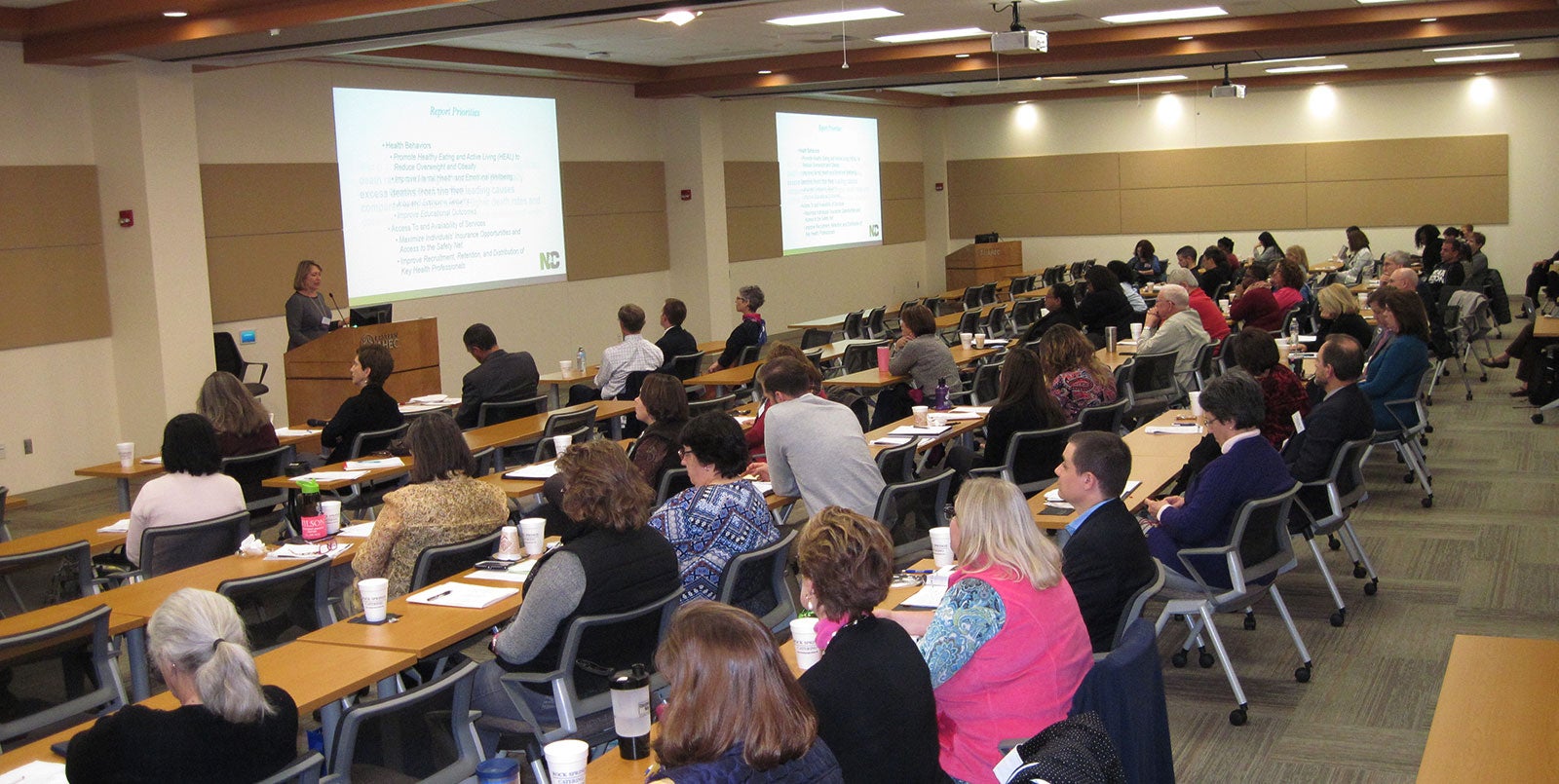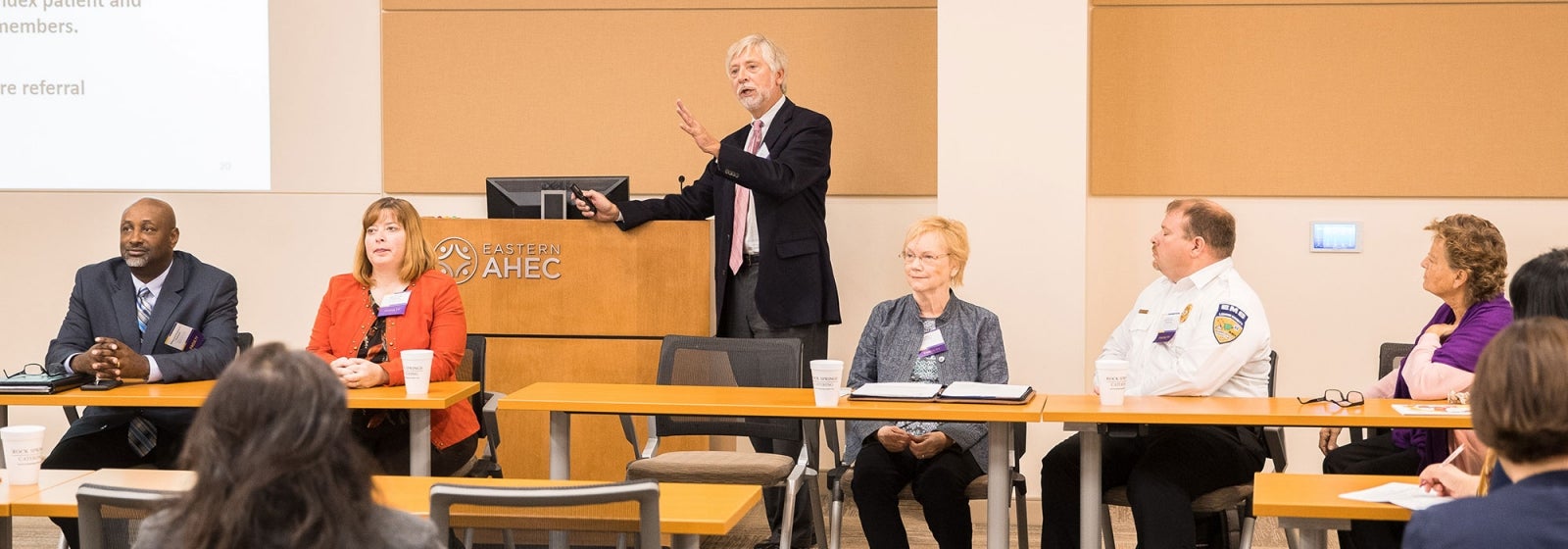CHALLENGES AND OPPORTUNITIES
Area health care professionals gather at first Rural Health Symposium
Health care professionals from across eastern North Carolina discussed both challenges and opportunities in rural health at a new conference Nov. 16-17.
Held at Eastern Area Health Education Center, the first Rural Health Symposium was a collaborative effort by many individuals and organizations, including Eastern AHEC, East Carolina University and Vidant Health.
Approximately 150 people were involved, with about 130 on site. All disciplines of health care were represented, as were 27 counties and 59 organizations. Topics included aging populations, health disparities, transportation solutions, telehealth, integrated care, community food resources, school based care, workforce diversity, and more.

Participants listen to presenters at the first Rural Health Symposium at Eastern Area Health Education Center.
“The quality and wealth of information presented far exceeded my expectations as a participant,” said Dr. Timothy Tolson of Albemarle Allergy and Asthma in Elizabeth City, who also helped plan the event. “I was amazed at the number of ongoing projects in the region as well as the positives for growth in communities and businesses moving forward. This program empowered participants with knowledge to take back to their communities.”
Nowhere is the rural-urban divide more evident than in the aging of North Carolina’s and the nation’s population, according to keynote speaker Dr. James Johnson of the Kenan-Flagler Business School at the University of North Carolina at Chapel Hill.
In 2011, the first baby boomer turned 65; since then, 8,000 people per day have joined their ranks across the nation. The U.S. will need 1.2 million additional senior care workers between now and 2025, according to Johnson. A number of changes are needed to help seniors age in place – employers must allow for elder care, facilities must become aging-friendly, and new technologies like GPS-tracker footwear can facilitate safer living at home.
“Aging will continue to drive growth,” Johnson said. “There’s got to be a profound change in everything we do.”
As more health care workers are needed, their location and distribution become key factors. Eighty of North Carolina’s 100 counties are classified as rural, according to Cornell Wright, executive director of the North Carolina Office of Minority Health and Health Disparities. Many are facing a shortage of health professionals. “We don’t have enough people where we need them to create health equity,” Wright said.
Diversity is another important factor in rural health. “The business world understands the importance of diversity; there are a lot of lessons we (in health care) can learn from them,” said Dr. Kendall Campbell, associate dean for diversity and inclusion at the Brody School of Medicine at ECU. “Diversity is not just numbers. There are benefits, like a larger talent pool and more creativity.”
One of the biggest challenges in providing health care in rural settings is that there are limited resources to provide care in these communities, according to Dr. Ronny Bell, chair of the Department of Public Health at ECU. “This is particularly true for specialty care and dental care,” he said. “Many people have to drive hours to get appropriate care, and it is very difficult to travel these long distances.”
Telehealth was one of several innovations discussed at the conference. Sixty-four percent of Americans reported they would attend an appointment via video, according to speaker Dr. Doyle “Skip” Cummings of ECU Family Medicine. “There is tremendous potential to provide access to healthcare,” he said.
The conference coincided with National Rural Health Day. On site to help celebrate was the North Carolina Office of Rural Health, which was the first such office in the nation, according to Director Maggie Sauer. “This is an amazing, transformational time,” she said.
The Rural Health Symposium is planned to be an annual event. This year those involved included 22 physicians, 29 nurses, seven nurse practitioners, six dentists, eight social workers, four pharmacists, and others.
“We want teams who attend this conference to take what they learn back to their practice setting to improve health, achieve better care experiences, foster joy in work, and reduce costs of healthcare,” said planning committee member Joan Wynn, chief quality officer at Vidant Home Health and Hospice.
“This symposium addresses key issues in our region that are different from our typical medical education, like barriers and challenges to providing care in eastern NC, as well as highlighted successes that hopefully can be replicated in other areas,” said Mildred Carraway, director of continuing medical, dental and pharmacy education for Eastern AHEC and Brody’s Office of CME.
For more upcoming continuing health care education programs, visit www.easternahec.net.

Approximately 130 people came to Eastern AHEC for the first Rural Health Symposium. (Photo by Jackie Drake)
